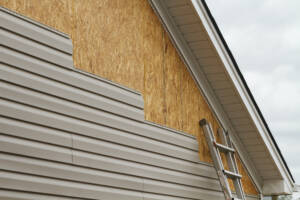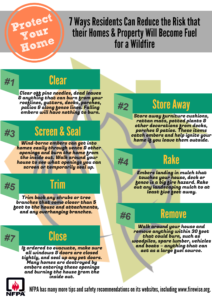Fire Resistant Siding
SIDING MATERIALS AND COATINGS
Siding products can be classified into three basic categories:
- combustible
- noncombustible
- ignition-resistant
The California Building Code defines the terms based on a material’s ability to pass a standard test.
 Noncombustible
Noncombustible
Common noncombustible materials include three-coat stucco, metal siding, and fiber cement siding.
Ignition-Resistant
An ignition-resistant material should not be confused with ignition-resistant construction. The latter takes into consideration all components and materials on the outside of the house, as well as the vegetation management plan used in the defensible space zone around the home. In California, combustible materials can be used in ignition-resistant construction.
Combustible
The most common combustible siding products include solid wood and other composite wood products (plywood, oriented strand board, and other compressed wood fiber products) and siding made from vinyl or other plastics. Wood that has been treated with an exterior fire-retardant chemical, and that has passed a standard flame spread test after undergoing a specified weathering procedure consisting of wetting and drying cycles, is called ignition resistant.
There are two ways that combustible siding can make your home vulnerable to wildfire. First, the siding can ignite, with flame spreading up the wall, providing a flame contact exposure to other components on the wall, including windows, eave (soffit), and vents. Under this scenario, the combustible siding transfers the problem to these other components. If the windows, eaves, and vents do not fail, the home will experience considerable damage but may not be destroyed. Under this scenario, however, total loss of the home is far more likely.
The second way combustible siding makes your home vulnerable to wildfire is when fire penetrates through the siding (most likely at a horizontal or vertical lap joint between individual pieces of the siding material), into the stud cavity, and then into the living space of the home. Under this scenario, the home will probably be lost, particularly if no one is present to put out the fire. When thinking about all the ways your home is vulnerable to wildfire exposures, a number of other components are more important (your roof, vents, windows, deck, and vegetation), but ultimately your siding can become the weak link. The importance of maintaining near-home vegetation and minimizing near-home storage of combustible materials has already been discussed, but when combustible siding is also used, these items become even more important to manage. Siding is also an important factor in home-to-home ignittion. If another building is adjacent to the house, consider noncombustible siding.
FIRE-RETARDANT TREATMENTS AND COATINGS
Exterior rated, fire-retardant-treated (FRT) wood products are pressure-impregnated with chemicals that improve the fire performance characteristics. These wood products undergo a processing step whereby these chemicals are fixed or otherwise contained to prevent or minimize leaching of the chemical. The process is similar to that used in preservative-treated lumber, which contains chemicals to resist attack from fungi and other wood-destroying organisms. In order to qualify as an exterior-use product, the treated wood must undergo accelerated or natural weathering cycles and pass subsequent fire tests to provide evidence of a prescribed level of performance over the intended service life of the product. There are practical and scientific reasons why a natural weathering cycle equivalent to the intended service life is not required prior to the product being accepted for use.
Instead of leaching losses from wetting, the more likely reduction in performance will be from in-service weathering (i.e., weathering resulting in the loss of wood fibers from the surface, thereby depleting the fire-retardant chemicals). Weathering will be variable, depending on exposure (i.e., the north, east, south, and west sides of your home), but it has been shown to be a slow process. The weathering process can be reduced considerably with a periodic application of a penetrating stain or a film-forming coating.
Stains and coatings are used for aesthetic reasons, and also to improve the resistance to certain exposures (e.g., weathering, fungi, and insects). Film-forming intumescent paints and penetrating stains, applied in the field, have not been shown to provide long-term, improved protection from fire exposures. None of these products have demonstrated long-term, fire-resistance performance in an exterior environment. Until these products can show adequate performance after a defined weathering procedure, they should not be relied on to improve the fire performance of exterior-use building materials.
A gel coating is a new fire protection alternative that is becoming more available to the homeowner. Gel coatings can be effective, assuming they are applied correctly and address points of fire entry as discussed in this publication. Gel coatings are purchased in a concentrate form, and can be applied to the home using a garden hose and an attachment that is supplied by the gel supplier. These coatings lose effectiveness with time (in the order of hours) as a result of water evaporation, but there is no data that evaluates the rate at which this reduction in effectiveness occurs. We do not think it is warranted to rely on a coating in lieu of managing vegetation or improving building materials or design.
Resource credit: FIRESafe MARIN
Resources
 Home Survival in Wildfire-Prone Areas: Building Materials and Design Considerations: ANR Publication 8393 15
Home Survival in Wildfire-Prone Areas: Building Materials and Design Considerations: ANR Publication 8393 15- Home Landscaping for Fire. University of California Publication 8228. 2007. University of California, Davis.
- www.readyforwildfire.org. Wildfire is Coming: Are You Ready. CAL FIRE. 2012.
- Urban Forestry Associates. Ray Moritz, Urban Forester and Fire Ecologist.
- Protecting Your Home From Wildfire. 2017. Insurance Institute for Business & Home Safety
PREPAREDNESS MENU
Prepare your Home
RESOURCES
Seven ways residents can reduce wildfire risk infographic by NFPA
Download the free wildfire safety infographic with seven tips for residents to help protect their homes in an event of a wildfire.
Wildfire risk reduction safety tips by NFPA
By working together, residents can make their own property, and their neighborhood, much safer from wildfire.


